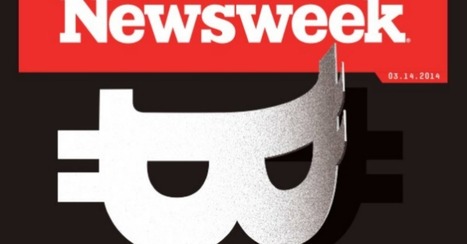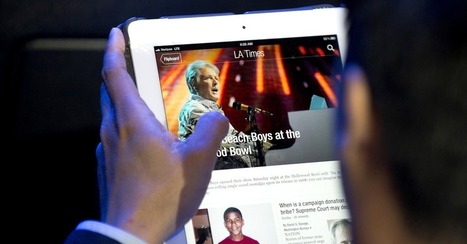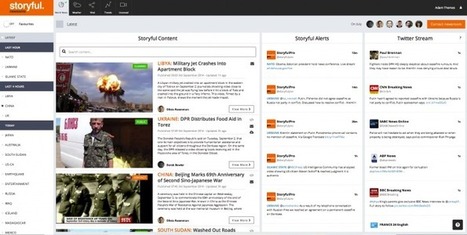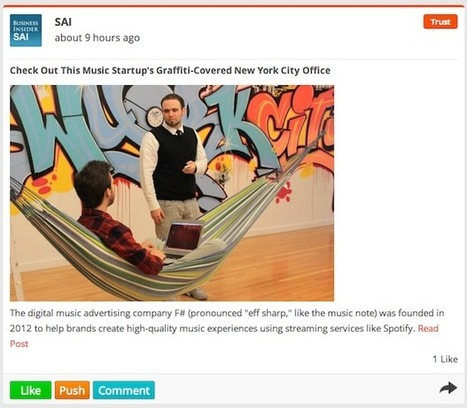 Your new post is loading...
 Your new post is loading...
The “we need to have something on this” impulse leads to the worst (professional) writing on the web. We all learn this anew each time some poor 20-something content producer writes some exceptionally dumb take, and everyone spends a few hours piling on the outlet that published it. But the attention-grabbing Offensive Takes only obscure the fact that all the inoffensive takes – the ephemeral, aggregated, feather-light blog posts telling people who already know that something happened that something happened, produced solely in the hopes that the post will, through luck and a bit of dark magic, win the Facebook algorithm lottery – are the most depressing pieces of writing on the web, for the reader and the writer.
The Internet media is exploitative and unkind to its greenest employees. Most of the Takes are written by 20-somethings making a (comparative) pittance. The Take is barely, if at all, edited. The young Take-producer is given no time to learn to report, or to read anything other than Everyone Else’s Takes. Dozens of aspiring journalists now have clips files that consist of hundreds of these awful aggregated units of completely disposable Content. Here’s 80 words on something James Franco did. Here’s 100 words on ISIS. This is my link to a Daily Mail story about long-lost twins who married each other....
All too often, we learn of revolutions in police states of third world countries from citizens on social media. This week, the stories and images online looked like a world away but unfortunately it was close to home. The stories of Ferguson, MO became national stories as they were shared by media and citizens on social media.
As the evolution of journalism continues on social media, storytelling through real-time mobile video is the latest shift. On Thursday, filmmakerCasey Neistat traveled to Ferguson with Vice News to cover the story for 24 hours. If you are not familiar with Casey’s work, check out his acclaimedYouTube channel to view.
In recent months, he began using Snapchat to share video stories and later posts to his Snapchat Stories YouTube channel. Instead of putting words in his mouth, I’ll let him explain...
Sites like Fortune and Bloomberg may cover financial news, but that doesn’t mean they have to do so without any flair. Here’s how business news sites redesigned their pages in an effort to stay modern while keeping their busy core readership constantly informed.
Magazine publishers have a tablet problem. According to one designer, they always have. Four years after Apple introduced the iPad, tablet apps are stagnating. A combination of design, pricing and discovery issues has made tablet magazines a hard sell, both for publishers and the digital readers they’re trying to reach.
“There are still a lot of issues,” said Joe Zeff, vice president of tablet app software company ScrollMotion, who helped launch apps for Fast Company and National Geographic.”These magazines are too hard to deliver, issues take a long time to download, and Apple’s Newsstand doesn’t make them easy to find. There are just too many things that have to go right.”
There was a time, not so long ago in the grand scheme, when the iPad was thought to be the savior of digital publishing. Magazines rushed out digital editions, many of which were flawed in both their pricing and in technology. The promised manna did not materialize. And now tablet sales are plateauing....
The Reuters Institute Digital Report reveals new insights about digital news consumption based on a representative survey of online news consumers in the USA, UK, Germany, France, Denmark, Finland, Spain, Italy, Urban Brazil and Japan.
This year's report reveals new insights about digital news consumption based on a YouGov survey of over 18,000 online news consumers in the UK, US, Germany, France, Italy, Spain, Brazil, Japan, Denmark and Finland.
This website contains data about the growth of tablets and smartphones, generational and country based differences in media usage. Also analysis on the role of impartial news in a digital world and the role of social media in finding and distributing news....
There’s inside baseball — and then there’s deep dives into the content management systems of America’s largest newspapers. Luke Vnenchak, director of content management systems at The New York Times, published a detailed walk through of the paper’s CMS today, giving an interesting glimpse at the technology responsible for publishing 700 articles, 600 images, 14 slideshows, and 50 videos on a daily basis.
Scoop (because of course the CMS is named Scoop) reminds me a little of a Lego set, at least from Vnenchak’s description, because the Times is continually building new additions and pieces on the original design. And it’s specifically about the management of content....
I don’t know what The Washington Post will look like in 2018, but I guarantee it will be in a business or two (or three) that no one could have predicted today.
Few people think that Bezos will defend the purity of journalism; his stewardship of Amazon offers clues that he’s comfortable wading into the gray area in exchange for revenue. The Amazon Vine program serves as a good Exhibit A....
The Verge editors think sharing analytics with reporters might distract them from quality storytelling. Other media outlets think differently.
While many news organizations freely share site metrics with their staff members, the growing availability of pageview and engagement data raises thorny news judgment questions that editors and reporters are grappling with on a daily basis.
Some sites, such as Gawker, have experimented with making pageviews a core part of reporters’ jobs by basing some aspects of pay on how much traffic their stories get, while others, such as The Verge, prefer their reporters avoid the temptation to pander to what’s popular. Still others take a middle road, allowing limited access to metrics....
Don Lemon's suggestion Sunday night that "supernatural" events may have been involved in the disappearance of the Malaysia Airlines left a lot of people with the same reaction: Where did that come from?
Don Lemon's suggestion Sunday night that "supernatural" events may have been involved in the disappearance of the Malaysia Airlines left a lot of people with the same reaction: Where did that come from?
A glance at the CNN anchor's Twitter feed might offer a clue. On Sunday, Lemon received a pointed message from a user under the handle @curryslap, who said he wanted "one of you dam media people" to "discuss the remote possibility of something super natural."...
'Newsweek' made a gutsy move publishing a cover story identifying the mysterious creator of Bitcoin.
Before Newsweek went ahead with publishing Leah McGrath Goodman's blockbuster article identifying the creator of Bitcoin, Goodman asked her editor an important question.
"Leah actually said to me, 'Are you ready for this? Are you ready for the shitstorm?'" Jim Impoco, Newsweek's editor in chief, recalled in a phone interview with Mashable on Friday. "And I said, 'yes.'
"SEE ALSO: 'Newsweek' Claims Bitcoin Creator Is 64 and Lives With His Mom
For the first few hours after the article was published online Thursday, Newsweek enjoyed the kind of attention that most publications would kill for. The Bitcoin story dominated the conversation on social media; 700,000 readers had viewed it as of 5 p.m. ET on Thursday, according to Impoco. It has since topped 1 million views....
Digital consumption of the news is quickly becoming the norm, with 64.5% of Americans now combing the headlines online.
NewsCred has launched a newsroom for brands seeking content marketing.
Who says no one's investing in journalism anymore?
NewsCred, a six-year-old New York-based content marketing company known for licensing articles from The Economist and the New York Times to brands, is creating its own newsroom with 500 journalists.
The writers, photographers, videographers and digital artists on contract with NewsCred will be at the disposal of brands seeking original content. The company is being selective about whom it hires. The pay is also decent: a minimum of $500 per blog post and $1,000 per article. The journalists get 100% of the fees for such articles. A NewsCred rep says the content is a value-add; the company's real business is in licensing its software platform, which a brand can use to upgrade their marketing outreach....
Police save hostages after militants storm Kenya shopping center with guns and grenades. This just in! TV discovers Twitter. At least that's how it seemed watching a recent national TV news story.
It felt like the early days of the internet, years ago. The CBC-TV news report I viewed fell well short of demonstrating the network knows how to use social media to cover a breaking story.
|
Storyful recently launched a new Newswire to some of the biggest newsrooms around the world. Today, Chief of Product Adam Thomas (@datatheism) outlines what's new. Modern news is evolving. Journalists need to find news fast.
This is where the magic happens. Essential videos, images and embedded social media, all verified by Storyful’s journalists and augmented with context, dates, geodata, maps, local photographs, corroborating social media and – crucially – contact information for sources, so that journalists can follow up, cross-check and create their own unique angle.
The journey from Newswire to article (or TV segment, or online video package, or listicle, or …) is vastly improved, with the aim to be as frictionless as possible. Where available, every piece of media now has download, share and embed buttons. If a content creator has opted to license their content, you contact us for instant guidance on prices and usage....
Our service offers all newspapers and magazines in the Netherlands on one website, and tries to reinvent the business model of journalism by making it incredibly easy to pay for separate articles. Users get €2,50 when they sign up and pay between €0,10 and €0,80 per article. When users click on an article, they automatically pay. And when they dislike what they read, they can instantly refund the article price.
Within Blendle, users can see what articles their friends or interesting curators (celebrities, journalists, politicians, radio DJ’s) have shared from the paid sections of today’s newspapers and magazines, and which articles are trending on the platform. The site also enables anyone to share articles from Holland’s best journalists on Facebook and Twitter. No more signing up with different paywalls for every newspaper....
And it’s all new money for the Times, about $149.1 million last year, a palpable performance in a short period of time. Put it another way, in a little over two-and-a-half years, the paywall went from $0 to $150 million.
But a slowdown in digital subscribers means it’ll be that much harder for the Times to make up for its losses elsewhere, specifically in advertising, once the life-blood of the business. The company lost close to $90 million in ad revenue — print and online together — from 2011 through last year, and it has been on a downward track ever since.
Online revenue alone would not sustain the New York Times as it exists today. If the Times were to become a digital-only newsroom, it’d be a $312 million business, including the $162.9 million in online ads it generated last year. But that’s only 20 percent of its current sales. In other words, a digital-only Times could just support a fifth of its current newsroom, or around 200 journalists....
...When the press writes about the current dislocations, they must insist that no one knows what will happen. This pattern shows up whenever the media covers itself. When the Tribune Company recently got rid of their newspapers, the New York Times ran the story under a headline “The Tribune Company’s publishing unit is being spun off, as the future of print remains unclear.”
The future of print remains what? Try to imagine a world where the future of print is unclear: Maybe 25 year olds will start demanding news from yesterday, delivered in an unshareable format once a day. Perhaps advertisers will decide “Click to buy” is for wimps. Mobile phones: could be a fad. After all, anything could happen with print. Hard to tell, really....
The New York Times has said it is planning to shut down or absorb as many as half of its existing blogs, with the hope that those skills can become more widespread inside the newspaper as a whole — but will they?
...Tom Taylor, co-founder of Newspaper Club tells The Verge that tests of the service have so far been positive. PaperLater appears to be a love or hate service, says Taylor. "The reaction [has been] divided between 'OMG I've wanted this all my life' and 'Why on earth would you print out the internet?'"
PaperLater will never take the place of services like Pocket — even Taylor admits to using it alongside a similar app. Short articles suitable for a commute go to the app, longer articles get pushed to the weekend for reading with PaperLater. "It's about giving people the choice to take something offline, and making it really easy to do that." As odd a service as it may seem, PaperLater's existence isn't without precedent.
Newspaper Club was founded with similar principles, and has been successfully running for years. Rather than offering an automated service like PaperLater, the site provides simple tools to create custom newspapers, and it's printed over four million newspapers since its formation in 2009....
Most of what we call news is filler. The practice of filling space and time — stuffing “content” into a “news hole” — is a relic of an era when printing and broadcast space and time were limited, privately held, and paid for mostly by advertising, which requires ears and eyeballs showing up predictably and in fixed places.
The Internet obsoleted all of it, including the frame of news as filler.
The river is a good metaphor for what news is, and should be. Sometimes it’s a trickle, sometimes a flood. But it always flows....
20 months, 1,740+ articles, and countless pitches later, I’ve got some truths to tell.
I know how a gazelle feels. There you are, working hard out on the savanna and then BAM! The predators descend, chasing you across the plains, licking their lips, watching your every move, ready to pounce at the first sign of vulnerability and squeeze every morsel they can out of you.
I spent nearly two years as a writer at VentureBeat. Replace lions, cheetahs, leopards, jackals, and hyenas with people from the startup scene and you get the idea. I often felt like a chewed up carcass at the end of a day.
Now that I am no longer a VB reporter, I am taking this moment to express some of my frustrations with the business of covering the tech industry, as well as provide a little insight about what not to do....
Last July, The Washington Post launched a live video channel that its president proclaimed would be “the ESPN of politics.” Instead, PostTV turned out to be more like a public access show. Within five months, the live content had vanished and the “channel” became little more than a clearinghouse for pre-taped video packages and recycled press briefing footage, along with the occasional original report.
What the Post learned in its video flop in 2013 is what The New York Times, The Wall Street Journal, POLITICO and other large news organizations had discovered in years prior: Creating quality live television is expensive — the Post invested millions of dollars and dozens of staffers to Post TV — and much harder than it looks. The end result didn’t interest readers — or advertisers....
News content optimizes differently, depending on platform. At the Missouri School of Journalism, students are testing new strategies to optimize platform-specific content with a goal of creating sequential usage patterns that can be measured and monetized.
...Our hypothesis? Different content optimizes to different platforms at different points in a progressive storytelling process. For instance, slideshows, “Five Things to Know,” and other short, easy-to-consume elements resonate on mobile phones. But because mobile has varying screen sizes and optimization opportunities, video clips and data visualization might resonate better on a tablet. The web becomes a placeholder for content early in the process, and then a repository or library for the sum of a day’s work or a story’s life cycle. And then there is the core product, “the show” or the paper or the newscast. Less and less likely to be the place where news is broken, it’s where depth is provided and value added. This is to say nothing of the role of social media and of how content is parsed in platform-specific and exclusive ways....
I’m interested to see if Sulia — a news recommendation platform that offers intelligent filtering by subject — can provide a suitable, more open alternative. But can diversity and precision really work well together?
Concept and LayoutSulia is a strange kind of hybrid. It feels like a social network, albeit one that is based around news; it has users, a kind of following system, and every post is adorned with controls such as Like and Comment. But it is also, quite clearly, a full-blown news aggregator, equipped with Prismatic-style intelligence, that pulls in stories from unaffiliated Twitter feeds, blogs and media outlets...
Newspaper consumption averaged 30 minutes per day in 2010, by 2013 that figure has been decimated to 18 minutes, a decline of 40%. These figures aren’t some flash in the pan or a freak event; they are signs of a trend that has been gaining traction in the last few years.
The self-proclaimed ‘oldest newspapers in the world’ Lloyds List, have recently announced that they are to move their entire operation online, the publication which has been in production since 1743 have made the decision to cease operation for their printed media on December 20th this year. This landmark decision was taken due to the shift in content digestion habits and general traffic of the everyday consumer, the decision, while not taken lightly was backed by years of research and given the overwhelming vote of support by their customer base.
What started out as a printed notice pinned on a café wall in London has now evolved into the shipping industry’s most sophisticated online intelligence tool that, through its online presence and modern day customer demand, is available anywhere at any time....
|



 Your new post is loading...
Your new post is loading...


































If you follow journalism this is a fascinating look at "takes" and how they are diminishing the value of online content in mainstream journalism. Highly recommended 9/10